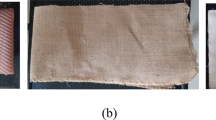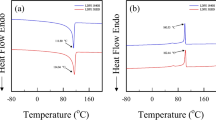Abstract
Fiber reinforced thermoplastics (FRP) have been widely used in automotive industry. However, how does the flow-fiber coupling effect influence the micro fiber orientation and further affect the geometrical shrinkage of the final part that is not fully understood yet. In this study, a complex center-gated plate has been applied to study the influence of the flow-fiber coupling effect on the fiber orientation variation and the geometrical change through numerical simulation. Then the practical verification through the micro-computed tomography (micro-CT) and image processing technology was carried out. Results show that in the presence of the flow-fiber coupling the required spruce pressure will be higher compared to no coupling case. In addition, the melt flow front pattern will be changed from “convex-flat” to “convex-concave” under the influence of this coupling. Moreover, in the presence of the flow-fiber coupling effect, the wider core width for fiber orientation tensor in the flow direction (A11) can be obtained from upstream to downstream regions for the same model. However, in the downstream region (i.e. in the FR), the flow-fiber coupling effect is more significantly due to the action of less shear rate in that region. Finally, through the measurement of the left–right asymmetrical shape of the FR for Model I (or Model II), the reason is that the flow-fiber coupling effect will switch the fiber orientation from the flow direction (A11) dominate to the cross-flow direction (A22) dominate. This asymmetrical fiber orientation distribution will further create that asymmetrical shrinkage shape of final part. The correlation between fiber orientation and geometrical shrinkage can be achieved.





















Similar content being viewed by others
References
CompositesWorld Report, Composites end markets: Automotive (2022), https://www.compositesworld.com/articles/composites-end-markets-automotive-2022, published: 2022/12/02, Accessed: 2022/02/02.
Othman, R., Ismail, N. I., Pahmi, M. A. A. H., Basri, M. H. M., Sharudin, H., & Hemdi, A. R. (2018). Application of carbon fiber reinforced plastics in automotive industry: A review. Journal of Mechanical Manufacturing, 1, 144–154.
U. S. Department of Energy report, Materials 2018 annual progress report (2018), Office of Energy Efficiency and Renewable Energy.
Der, A., Kaluza, A., Reimer, L., Herrmann, C., & Thiede, S. (2022). Integration of energyoriented manufacturing simulation into the life cycle evaluation of lightweight body parts. International Journal of Precision Engineering and Manufacturing-Green Technology, Published online, 2022(01/03), 1–18. https://doi.org/10.1007/s40684-021-00412-w
Garate, J., Solovitz, S. A., & Kim, D. (2018). Fabrication and performance of segmented thermoplastic composite wind turbine blades. International Journal of Precision Engineering and Manufacturing-Green Technology, 5, 271–277.
Thomason, J. L., & Vlug, M. A. (1996). Influence of fiber length and concentration on the properties of glass fiber-reinforced polypropylene: Part 1-Tensile and flexural modulus. Composites, 27A, 477–484.
Thomason, J. L. (2007). The influence of fibre length and concentration on the properties of glass fibre reinforced polypropylene: Interface strength and fibre strain in injection moulded long fibre PP at high fibre content. Compost. Part A Appl. Sci. Manuf., 38, 210–216.
Wang, C., & Yang, S. (2013). Thermal, tensile and dynamic mechanical properties of short carbon fibre reinforced polypropylene composites. Polymer & Polymer Composites, 21(2), 65–71.
Cilleruelo, L., Lafranche, E., Krawczak, P., Pardo, P., & Lucas, P. (2012). Injection moulding of long glass fibre reinforced poly(ethylene terephtalate): Influence of carbon black and nucleating agents on impact properties. Express Polymer Letters, 6(9), 706–718.
Rohde, M., Ebel, A., Wolff-Fabris, F., & Altstädt, V. (2011). Influence of processing parameters on the fiber length and impact properties of injection molded long glass fiber reinforced polypropylene. International polymer processing, 26(3), 292–303.
Goris, S., Back, T., Yanev, A., Brands, D., Drummer, D., & Osswald, T. A. (2018). A novel fiber length measurement technique for discontinuous fiber-reinforced composites: A comparative study with existing methods. Polymer Composites, 39(11), 4058–4070.
Nguyen, B. N., Bapanapalli, S. K., Holbery, J. D., Smith, M. T., Kunc, V., Frame, B. J., Phelps, J. H., & Tucker, C. L. (2008). Fiber length and orientation in long-fiber injection-molded thermoplastics-Part I: Modeling of microstructure and elastic Properties. Journal of Composite Materials, 42(10), 1003–1029.
Bernasconi, A., Cosmi, F., & Hine, P. J. (2012). Analysis of fibre orientation distribution in short fibre reinforced polymers: A comparison between optical and tomographic methods. Composites Science and Technology, 72, 2002–2008.
Gandhi, U., Goris, S., & D. B., Kunc, V. and Song, Y. Y. (2015). Method to measure orientation of discontinuous fiber embedded in the polymer matrix from computerized tomography scan data. Journal of Thermoplastic Composite Materials, 29(12), 1–14. https://doi.org/10.1177/0892705715584411
Teuwsen, J., Goris, S. and Osswald, T. A. (2017). Impact of the process-induced microstructure on the mechanical performance of injection molded long glass fiber reinforced polypropylene, SPE ANTEC Annual Tech Paper, 626–635.
Huang, C. T., Chu, J. H., Fu, W. W., Hsu, C., & Hwang, S. J. (2021). Flow-induced orientations of fibers and their influences on warpage and mechanical property in injection fiber reinforced plastic (FRP) Parts. International Journal of Precision Engineering and Manufacturing-Green Technology, 8(3), 917–934.
Folgar, F., & Tucker, C. L. (1984). Orientation behavior of fibers in concentrated suspensions. Journal of Reinforced Plastics and Composites., 3(2), 98–119.
Advani, S. G., & Tucker, C. L. (1987). The use of tensors to describe and predict fiber orientation in short fiber composites”. Journal of Rheology, 31(8), 751–784.
Advani, S. G. (1994). Flow and Rheology in Polymer Composites Manufacturing. Elsevier.
Vincent, M., Giroud, T., Clarke, A., & Eberhardt, C. (2005). Description and modeling of fiber orientation in injection molding of fiber reinforced thermoplastics. Polymer, 46(17), 6719–6725.
Ortman, K., Baird, D., Wapperom, P., & Aning, A. (2012). Prediction of fiber orientation in the iInjection molding of long fiber suspensions. Polymer composites, 33(8), 1360–1367.
Phelps, J. H., & Tucker, C. L., III. (2009). An anisotropic rotary diffusion model for fiber orientation in short- and long-fiber thermoplastics. J. Non-Newton. Fluid Mech., 56, 165–176.
Wang, J., O’Gara, J. F., & Tucker, C. L., III. (2008). An objective model for slow orientation kinetics in concentrated fiber suspensions: Theory and rheological evidence. Journal of Rheology, 52, 1179–1200.
Wang, J. and **, X. (2010). Comparison of recent fiber orientation models in autodesk moldflow insight simulations with measured fiber orientation data, Proceedings of the Polymer Processing Society 26th Annual Meeting (PPS-26), July 4–8, 2010, Banff, Canada.
Tseng, H. C., Chang, R. Y., & Hsu, C. H. (2013). Phenomenological improvements to predictive models of fiber orientation in concentrated suspensions. Journal of Rheology, 57, 1597–1631.
Foss, P. H., Tseng, H.-C., Snawerdt, J., Chang, Y.-J., Yang, W.-H., & Hsu, C.-H. (2014). Prediction of fiber orientation distribution in injection molded parts using Moldex3D simulation. Polymer Composites, 35(4), 671–680.
Libscomb, G. G., Denn, M. M., Hur, D. U., & Boger, D. V. (1988). The flow of fiber suspensions in complex geometries. J. Non-Newt. Fluid Mech., 26, 297–325.
VerWeyst, B. E., & Tucker, C. L., III. (2002). Fiber suspensions in complex geometries: Flow/orientation coupling. Canadian Journal of Chemical Engineering, 80, 1093–1106.
Tseng, H.C., and Su, T.H. “Coupled flow and fiber orientation analysis for 3D injection molding simulations of fiber composites”, Proceedings of the Polymer Processing Society 34th Annual Meeting (PPS-34), AIP Conf. Proc. 2065, 030021–1–030021–5; https://doi.org/10.1063/1.5088279.
Favaloro, A. J., Tseng, H. C., & Pipes, R. B. (2018). A new anisotropic viscous constitutive model or composite molding simulation. Composite Part A, 115, 112–122.
Tseng, H. C., & Favaloro, A. J. (2019). The use of informed isotropic constitutive equation to simulate anisotropic rheological behaviors in fiber suspensions. Journal of Rheology, 63, 263–274.
Huang, C. T., & Lai, C. H. (2020). Investigation on the coupling effects between flow and fibers on fiber-reinforced plastic (FRP) injection parts. Polymers, 12(10), 2274.
Acknowledgements
The authors would like to thank Ministry of Science and Technology of Taiwan, R.O.C. (Project number: MOST 110-2221-E-032 -015 -; MOST 108-2221-E-032-013-MY2; MOST 107-2622-E-006 -024 -CC1) for partly financially supporting for this research.
Author information
Authors and Affiliations
Corresponding author
Ethics declarations
Conflict of interest
On behalf of all authors, the corresponding author states that there is no conflict of interest.
Additional information
Publisher's Note
Springer Nature remains neutral with regard to jurisdictional claims in published maps and institutional affiliations.
Rights and permissions
Springer Nature or its licensor holds exclusive rights to this article under a publishing agreement with the author(s) or other rightsholder(s); author self-archiving of the accepted manuscript version of this article is solely governed by the terms of such publishing agreement and applicable law.
About this article
Cite this article
Huang, CT., Wang, JZ., Lai, CH. et al. Correlation Between Fiber Orientation and Geometrical Shrinkage of Injected Parts Under the Influence of Flow-Fiber Coupling Effect. Int. J. of Precis. Eng. and Manuf.-Green Tech. 10, 1039–1060 (2023). https://doi.org/10.1007/s40684-022-00473-5
Received:
Revised:
Accepted:
Published:
Issue Date:
DOI: https://doi.org/10.1007/s40684-022-00473-5




